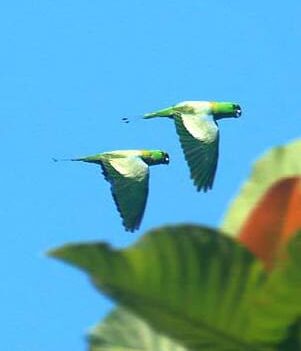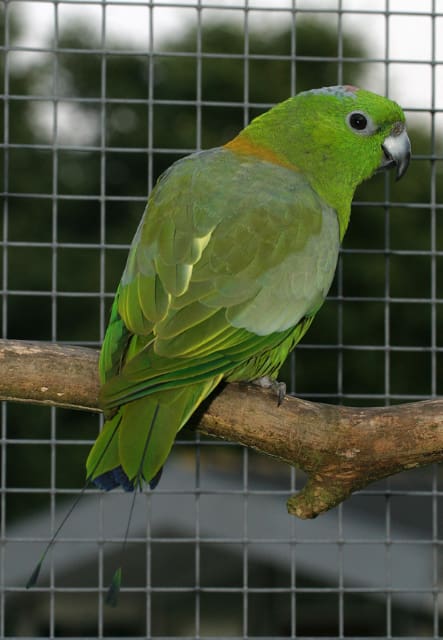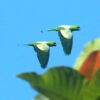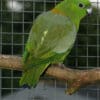Golden-mantled Racquet-tailed Parrot
Also known as:
Golden-mantled Racquet-tail, Gold-mantled Racquet-tail, Gold-backed Racquet-tailed Parrot
Also known as:
Golden-mantled Racquet-tail, Gold-mantled Racquet-tail, Gold-backed Racquet-tailed Parrot
DID YOU KNOW?
The Golden-mantled Racquet-tail travels widely in daily forays to search for fruiting trees.

Prioniturus

platurus
Size:
28 cm (10.9 in)
Weight:
200-225 g (7-7.9 oz)
Subspecies including nominate:
three: P.p. platurus, P.p. talautensis, P.p. sinerubris
Colour Adult:
P.p. platurus: Male-back of crown is a pink/red spot, bordered by dull blue/grey patch reaching to nape; orange/yellow stripe across mantle; lower mantle blue/grey and upper wing coverts dull grey. Pale yellow margins on inner webs of secondary feathers; green centre tail feathers, the “racquets” black washed with blue, side tail feathers green banded with black near the end. Beak dark grey, paler at base. Eye dark brown. Female-crown green; mantle green, orange/yellow band absent; upper wing coverts green with varying grey wash.
P.p. talautensis: Male-in general paler; less grey mantle and upper wing coverts; more evident pink/red spot on hindcrown with more blue patch. Female-as in platurus, but paler green.
P.p. sinerubris: Male-pink/red spot absent from hindcrown; mantle and upper wing coverts green, lightly washed with grey; bend of wing and lesser wing coverts suffused with purple; smaller.
Colour Juvenile:
P.p. platurus: As in female but no bare tail shafts.
P.p. talautensis: As in platurus but paler green.
P.p. sinerubris: Undescribed.
Call:
Distinctive from other racquet-tails; musical, slurred and moderately high-pitched whistling notes; some calls harsh and nasal.
More Information:
Content Sources:
CITES
BirdLife International
Cornell Lab of Ornithology/Birds of the World
Parrots: A Guide to Parrots of the World, Juniper and Parr, 1998
Parrots of the World, Forshaw, 2006. 2010 edition
Parrots in Aviculture, Low, 1992.
Lexicon of Parrots, Thomas Arndt.
Captive Status:
Rare
Longevity:
—
Housing:
Walk-in enclosure, minimum length 3 m (9.8 ft).
Diet:
Fruit such as: apple, pear, orange, cactus fruits, pomegranate; forming about 30% of the diet; vegetables such as: carrot, celery, green peas and beans; fresh corn, green leaves such as: Swiss chard, lettuce, sowthistle, dandelion, chickweed; spray millet; small seed mix such as: millet, canary and smaller amounts of safflower, buckwheat and a little hemp; soaked or sprouted sunflower seed; cooked beans and pulses, complete pellet.
Enrichment:
Fresh bird-safe, unsprayed fir, flowering, elder, pine or willow branches and other bird-safe chewables (vegetable-tanned leather toys, heat-sterilised pine cones).
Nest Box Size:
10″ x 10″ x 22″ (25.4 cm x 25.4 cm x 55.9 cm) vertical box.
Clutch Size:
Probably 3 to 5.
Fledging Age:
—
Hatch Weight:
—
Peak Weight:
—
Weaning Weight:
—
World Population:
Unknown but recorded as common, declining.
IUCN Red List Status:
Least Concern
CITES Listing:
Appendix II
Threat Summary:
Not globally threatened. A BirdLife “restricted-range” species. Evidence of small decline in population; talautensis less secure, platurus and sinerubris more secure.
Range:
P.p. platurus: Sulawesi, including Siau, Lembeh, Dodepo, Muna and Butung Islands and Togian and Banggai Islands.
P.p. talautensis: Karakelong and Salebabu, Taulaud Islands.
P.p. sinerubris: Taliabu and Mangole, Sula Islands.
Habitat:
Found in humid forest edge, woodlands, orchards and moss forest from the lowlands up to 2000 m (6560 ft).
Wild Diet:
Includes fruit (mangoes), seeds and blossoms. Also takes corn and mangoes on occasion.
Ecology and Behaviour:
Found in small, noisy groups of up to 20; heard before seen; occasionally forms large flocks of several hundred birds. Shy while feeding and easily overlooked. Travels widely in search of fruiting trees.
Clutch and Egg Size:
Probably 3 to 5.
Breeding Season:
October; nest is in tree cavity.
Related Links:
—



